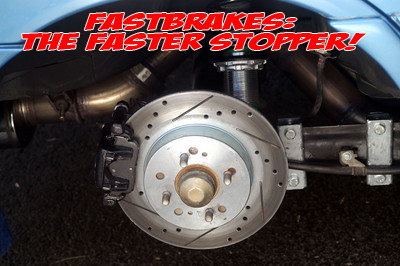 |
| Sarah sez, “No Phat 19″ chrome wheels on EVOs”. |
Ask Sarah
By Sarah Forst
I know back pressure is bad. Everything I remember about high school physics and everything I read over the years from SCC and Honda Tuning tells me back pressure is bad. I made that statement the other night at the pub to a friend. I found myself trying to make the argument without any scientific facts. He drives a 5 year old Mustang GT and claims he needs back pressure for his engine to work. He claims to have dynoed it with open headers and it lost power.
His theory is back pressure keeps fresh air in the cylinder during that fraction of a second of valve overlap, when both intake and exhaust are open. I think he was losing power because the improved airflow was causing him to run too lean. What are the facts on back pressure?
John Walker
Got a Tech Question? Email Sarah at asksarah@motoiq.com
Aw, the age old backpressure theory. Backpressure is not necessary for power, it always hurts power production. In fact, it is a byproduct of restriction to flow, creating pumping losses that sap power. Increased backpressure can lead to reversion, when exhaust gases flow back into the combustion chamber and dilute the fresh intake charge. A header increases power by extracting the greatest volume of exhaust gases, which is a function of increased volumetric efficiency. Headers work by having very low backpressure combined with high velocity flow to exploit acoustic and kinetic energy in the exhaust stream. This improves cylinder scavenging especially during overlap, the period of time when both the intake and exhaust valves are open at the same time. We go into much more detail in two header articlesI wrote here, and here in part two.
 |
| Remember this graph I made? Learn it, live it, love it. Seriously, this is what goes on in the primary tube of a properly sized and designed header. Getting rid of the backpressure behind such a header will only allow it to work better. If the header is not optimized, especially with primary tubes too big and too short for the engine, then reducing backpressure can throw everything really out of kilter. |
The theories in these articles can explain why your friend lost power when he dyno’d his GT without any headers and will also provide much more detailed information on header design. A tuned header does a lot to produce power, including reducing cross contamination of flow between cylinders adjacent in the firing order, which keeps the intake charge from becoming diluted. It also improves scavenging, the removal of exhaust gases from the cylinder. After the initial pulse of high pressure exhaust gases leaves the cylinder, a vacuum is created by the negative pressure rarefaction wave that develops near the exhaust valves. The header design here is important as this event must be timed to occur during overlap. This vacuum helps pull the remainder of burnt exhaust gases out of the cylinder, allowing a fresh intake charge into the cylinders.
Backpressure will actually lower the pressure gradient, the difference between the high pressure in the exhaust port and the lower pressure in the header and exhaust system. Air (all “fluids” really) flow from high pressure areas to low pressure areas and it is this difference in pressure systems that helps keep the exhaust gas flow velocity high. This pressure gradient discussion is often confused for backpressure.
So how did this backpressure myth ever get perpetuated? Well, a lot of people will run open headers or use a header with primary pipes that are too large in diameter, and lose power. They think, well, I just got rid of my backpressure and now I have no power. But what really happened is they killed off the flow velocity by going with pipes that were too big. Tuned headers are designed with piping diameter in mind to keep from losing the necessary exhaust gas velocity.
 |
| The custom ASP header is off of Mike Kojima's race car. You can bet its designed properly and makes lots of power, even when uncorked with no exhaust at all. I can't say the same for some poorly designed or improperly spec'ed headers. |
Alas, I can’t end this discussion without disseminating one other backpressure myth: backpressure is necessary to keep the engine from running lean and burning valves. Less backpressure will allow more air to be drawn into the combustion chamber. Older cars, carbureted cars, usually delivered a second round of fuel when the backpressure induced reversion pushed air back through the carburetor so it could get a second shot of fuel. You can sometimes see this reversion cloud on a carbureted car on an engine dyno. Any modification that reduced backpressure and its reversion effect could then cause the car to run lean by not providing that second hit of fuel. Modern vehicles are equipped with engine management systems with O2 sensor feedback that can adjust for changes that affect air and fuel such as a bolt-on headers. In fact, your lost power because dumping the exhaust system reduced velocity and scavenging in the headers primary pipes which were probably improperly sized for his build.



